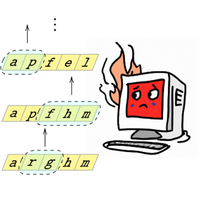Glassy Word Problems: Ultraslow Relaxation, Hilbert Space Jamming, and Computational Complexity
IF 11.6
1区 物理与天体物理
Q1 PHYSICS, MULTIDISCIPLINARY
引用次数: 0
Abstract
We introduce a family of local models of dynamics based on “word problems” from computer science and group theory, for which we can place rigorous lower bounds on relaxation timescales. These models can be regarded either as random circuit or local Hamiltonian dynamics and include many familiar examples of constrained dynamics as special cases. The configuration space of these models splits into dynamically disconnected sectors, and for initial states to relax, they must “work out” the other states in the sector to which they belong. When this problem has a high time complexity, relaxation is slow. In some of the cases we study, this problem also has high space complexity. When the space complexity is larger than the system size, an unconventional type of jamming transition can occur, whereby a system of a fixed size is not ergodic but can be made ergodic by appending a large reservoir of sites in a trivial product state. This finding manifests itself in a new type of Hilbert space fragmentation that we call fragile fragmentation. We present explicit examples where slow relaxation and jamming strongly modify the hydrodynamics of conserved densities. In one example, density modulations of wave vector exhibit almost no relaxation until times , at which point they abruptly collapse. We also comment on extensions of our results to higher dimensions.

玻璃文字问题:超低松弛、希尔伯特空间干扰和计算复杂性
我们以计算机科学和群论中的 "文字问题 "为基础,介绍了一系列局部动力学模型,我们可以为这些模型设定严格的松弛时间尺度下限。这些模型既可视为随机电路模型,也可视为局部哈密顿动力学模型,还包括许多我们熟悉的约束动力学特例。这些模型的构型空间分裂成动态断开的扇区,初始态要弛豫,就必须 "解决 "其所属扇区中的其他态。当这个问题的时间复杂度很高时,弛豫的速度就会很慢。在我们研究的一些案例中,这个问题的空间复杂度也很高。当空间复杂度大于系统大小时,就会出现一种非常规的干扰转换,即一个固定大小的系统不是遍历的,但可以通过在琐积状态中添加大量的位点库来使其成为遍历的。这一发现表现为一种新型的希尔伯特空间碎片化,我们称之为脆弱碎片化。我们举例说明了缓慢松弛和干扰会强烈改变守恒密度的流体力学。在其中一个例子中,波矢量 q 的密度调制几乎没有松弛,直到 O(exp(1/q))倍,此时它们突然坍缩。我们还评论了将我们的结果扩展到更高维度的问题。
本文章由计算机程序翻译,如有差异,请以英文原文为准。
求助全文
约1分钟内获得全文
求助全文
来源期刊

Physical Review X
PHYSICS, MULTIDISCIPLINARY-
CiteScore
24.60
自引率
1.60%
发文量
197
审稿时长
3 months
期刊介绍:
Physical Review X (PRX) stands as an exclusively online, fully open-access journal, emphasizing innovation, quality, and enduring impact in the scientific content it disseminates. Devoted to showcasing a curated selection of papers from pure, applied, and interdisciplinary physics, PRX aims to feature work with the potential to shape current and future research while leaving a lasting and profound impact in their respective fields. Encompassing the entire spectrum of physics subject areas, PRX places a special focus on groundbreaking interdisciplinary research with broad-reaching influence.
 求助内容:
求助内容: 应助结果提醒方式:
应助结果提醒方式:


